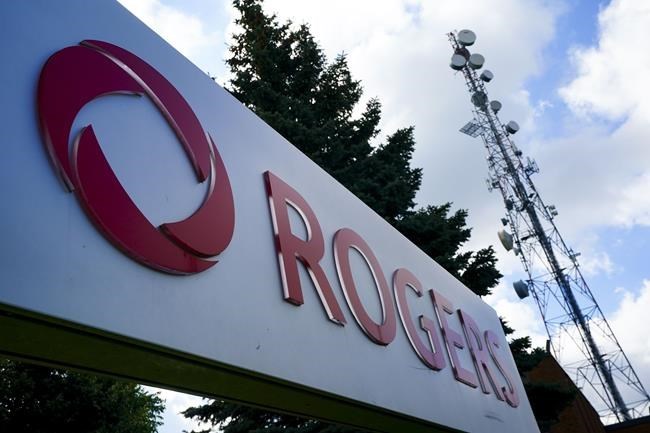The chief executive of Rogers Communications Inc. dismissed analyst concerns about wireless customers leaving the carrier, saying the company was focused on its premium brand where performance was stronger.
Speaking Thursday on the company's fourth-quarter earnings call, Rogers CEO Tony Staffieri said there was a "heightened level of what I would call promotional activity in the bottom end of the market" toward the end of last year, suggesting customers opted for rival carriers that offered better deals.
He said that caused Rogers' brands such as Fido, part of a group of discount brands called flankers, to lose some phone customers to rivals.
The company's overall monthly churn for net postpaid mobile phone subscribers — a closely watched industry measure of those who cancelled their service — was 1.67 per cent, up from 1.24 per cent during its previous fourth quarter.
"I'll jump to the punchline, which is we're not concerned about what we're seeing on churn," said Staffieri.
"We chose to focus — and not that we neglected that segment — but our focus was on the premium. So when you look at gross adds for us, they're up significantly year on year. The vast, vast majority of those came in on the Rogers brand."
Rogers reported its net increase in postpaid mobile phone subscribers totalled 184,000 for the three-month period, which it credited to "sales execution in a growing Canadian market." The figure was down 4.7 per cent from the 193,000 additions recorded the same period last year.
Staffieri said churn associated with the Rogers mobile brand is "substantially lower than Fido." He added that the flurry of deals started to fade in the first quarter of 2024, while sidestepping an analyst question about whether Rogers' recently announced price increases could further affect its churn rate.
Staffieri also noted Rogers does "extremely well" in attracting customers who are new to sa���ʴ�ý, such as foreign students and temporary workers, but the transient nature of that demographic can lead to fluctuations in subscription totals.
"What you're seeing is a phenomenon as they come in and out of the country that's driving a healthier gross add, but you're seeing those churn numbers come through as well," he said.
Last month, Immigration Minister Marc Miller announced new limits to sa���ʴ�ý's international student program, including a 35-per cent reduction in the number of study permits it issues this year.
Asked about the federal government's plan to cap the number of international students granted permission to study in sa���ʴ�ý, Staffieri said there "will certainly be an impact."
"But we see it as small in the context of the overall market growth," he added, as Rogers estimates sa���ʴ�ý's wireless market will grow by at least four per cent in 2024 after exceeding five per cent growth last year.
Rogers reported Thursday its fourth-quarter net income fell 35 per cent compared with a year ago as it was hit by costs related to its acquisition of Shaw Communications Inc. and integrating the business.
The company reported net income of $328 million or 62 cents per diluted share for the quarter ended Dec. 31 compared with $508 million or $1 per diluted share a year earlier.
On an adjusted basis, Rogers earned $1.19 per diluted share in last three months of 2023, up from $1.09 per diluted share in the last three months of 2022. That beat analysts' expectations of $1.10 in earnings per share, according to financial markets data firm Refinitiv.
The results "were slightly ahead of our expectations with minimal surprises, which we view as a modest positive for the shares at current levels," RBC Capital Markets analyst Drew McReynolds said in a note.
Revenue for the quarter totalled nearly $5.34 billion, up from nearly $4.17 billion a year earlier. The increase came as wireless service revenue rose nine per cent, helped by revenue from Shaw Mobile subscribers. Wireless equipment revenue gained 17 per cent.
Rogers' mobile phone average monthly revenue per user was $57.96, marking a 1.2 per cent decrease from the fourth quarter of the prior year.
The company also remained six months ahead of schedule on achieving its cost cutting goals associated with the Shaw merger, which closed in April of last year.
It said it has realized $375 million in total savings so far as it targets annual savings of around $1 billion by the end of 2024. Most of the remaining cost cuts will likely come through contract negotiations with vendors, said chief financial officer Glenn Brandt, after layoffs and a voluntary departure program last year.
"We are largely through the people part of the integration exercise," he said.
Rogers said cable service revenue increased by 94 per cent, primarily as a result of the Shaw deal, while media revenue fell eight per cent as a result of lower sports-related revenue, partially offset by higher advertising and subscriber revenue.
This report by The Canadian Press was first published Feb. 1, 2024.
Companies in this story: (TSX:RCI.B)
Sammy Hudes, The Canadian Press


